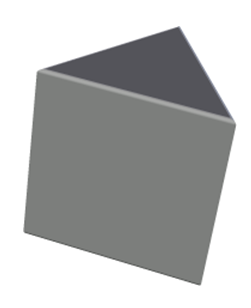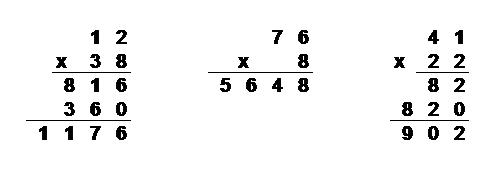Hints will display for most wrong answers; explanations for most right answers. You can attempt a question multiple times; it will only be scored correct if you get it right the first time. To see ten new questions, reload the page.
I used the official objectives and sample test to construct these questions, but cannot promise that they accurately reflect what’s on the real test. Some of the sample questions were more convoluted than I could bear to write. See terms of use. See the MTEL Practice Test main page to view questions on a particular topic or to download paper practice tests.
MTEL General Curriculum Mathematics Practice
Question 1 |
Which of the following sets of polygons can be assembled to form a pentagonal pyramid?
2 pentagons and 5 rectangles.Hint: These can be assembled to form a pentagonal prism, not a pentagonal pyramid. | |
1 square and 5 equilateral triangles.Hint: You need a pentagon for a pentagonal pyramid. | |
1 pentagon and 5 isosceles triangles. | |
1 pentagon and 10 isosceles triangles. |
Question 2 |
A cylindrical soup can has diameter 7 cm and height 11 cm. The can holds g grams of soup. How many grams of the same soup could a cylindrical can with diameter 14 cm and height 33 cm hold?
\( \large 6g\) Hint: You must scale in all three dimensions. | |
\( \large 12g\) Hint: Height is multiplied by 3, and diameter and radius are multiplied by 2. Since the radius is squared, final result is multiplied by \(2^2\times 3=12\). | |
\( \large 18g\) Hint: Don't square the height scale factor. | |
\( \large 36g\) Hint: Don't square the height scale factor. |
Question 3 |
Taxicab fares in Boston (Spring 2012) are $2.60 for the first \(\dfrac{1}{7}\) of a mile or less and $0.40 for each \(\dfrac{1}{7}\) of a mile after that.
Let d represent the distance a passenger travels in miles (with \(d>\dfrac{1}{7}\)). Which of the following expressions represents the total fare?
\( \large \$2.60+\$0.40d\) Hint: It's 40 cents for 1/7 of a mile, not per mile. | |
\( \large \$2.60+\$0.40\dfrac{d}{7}\) Hint: According to this equation, going 7 miles would cost $3; does that make sense? | |
\( \large \$2.20+\$2.80d\) Hint: You can think of the fare as $2.20 to enter the cab, and then $0.40 for each 1/7 of a mile, including the first 1/7 of a mile (or $2.80 per mile).
Alternatively, you pay $2.60 for the first 1/7 of a mile, and then $2.80 per mile for d-1/7 miles. The total is 2.60+2.80(d-1/7) = 2.60+ 2.80d -.40 = 2.20+2.80d. | |
\( \large \$2.60+\$2.80d\) Hint: Don't count the first 1/7 of a mile twice. |
Question 4 |
Use the expression below to answer the question that follows:
\( \large \dfrac{\left( 7,154 \right)\times \left( 896 \right)}{216}\)
Which of the following is the best estimate of the expression above?
2,000Hint: The answer is bigger than 7,000. | |
20,000Hint: Estimate 896/216 first. | |
3,000Hint: The answer is bigger than 7,000. | |
30,000Hint: \( \dfrac{896}{216} \approx 4\) and \(7154 \times 4\) is over 28,000, so this answer is closest. |
Question 5 |
What is the mathematical name of the three-dimensional polyhedron depicted below?

TetrahedronHint: All the faces of a tetrahedron are triangles. | |
Triangular PrismHint: A prism has two congruent, parallel bases, connected by parallelograms (since this is a right prism, the parallelograms are rectangles). | |
Triangular PyramidHint: A pyramid has one base, not two. | |
TrigonHint: A trigon is a triangle (this is not a common term). |
Question 6 |
Here is a student's work on several multiplication problems:
 For which of the following problems is this student most likely to get the correct solution, even though he is using an incorrect algorithm?
For which of the following problems is this student most likely to get the correct solution, even though he is using an incorrect algorithm?
58 x 22Hint: This problem involves regrouping, which the student does not do correctly. | |
16 x 24Hint: This problem involves regrouping, which the student does not do correctly. | |
31 x 23Hint: There is no regrouping with this problem. | |
141 x 32Hint: This problem involves regrouping, which the student does not do correctly. |
Question 7 |
Use the expression below to answer the question that follows.
\( \large \dfrac{\left( 4\times {{10}^{3}} \right)\times \left( 3\times {{10}^{4}} \right)}{6\times {{10}^{6}}}\)
Which of the following is equivalent to the expression above?
2Hint: \(10^3 \times 10^4=10^7\), and note that if you're guessing when the answers are so closely related, you're generally better off guessing one of the middle numbers. | |
20Hint: \( \dfrac{\left( 4\times {{10}^{3}} \right)\times \left( 3\times {{10}^{4}} \right)}{6\times {{10}^{6}}}=\dfrac {12 \times {{10}^{7}}}{6\times {{10}^{6}}}=\)\(2 \times {{10}^{1}}=20 \) | |
200Hint: \(10^3 \times 10^4=10^7\) | |
2000Hint: \(10^3 \times 10^4=10^7\), and note that if you're guessing when the answers are so closely related, you're generally better off guessing one of the middle numbers. |
Question 8 |
On a map the distance from Boston to Detroit is 6 cm, and these two cities are 702 miles away from each other. Assuming the scale of the map is the same throughout, which answer below is closest to the distance between Boston and San Francisco on the map, given that they are 2,708 miles away from each other?
21 cmHint: How many miles would correspond to 24 cm on the map? Try adjusting from there. | |
22 cmHint: How many miles would correspond to 24 cm on the map? Try adjusting from there. | |
23 cmHint: One way to solve this without a calculator is to note that 4 groups of 6 cm is 2808 miles, which is 100 miles too much. Then 100 miles would be about 1/7 th of 6 cm, or about 1 cm less than 24 cm. | |
24 cmHint: 4 groups of 6 cm is over 2800 miles on the map, which is too much. |
Question 9 |
The least common multiple of 60 and N is 1260. Which of the following could be the prime factorization of N?
\( \large2\cdot 5\cdot 7\) Hint: 1260 is divisible by 9 and 60 is not, so N must be divisible by 9 for 1260 to be the LCM. | |
\( \large{{2}^{3}}\cdot {{3}^{2}}\cdot 5 \cdot 7\) Hint: 1260 is not divisible by 8, so it isn't a multiple of this N. | |
\( \large3 \cdot 5 \cdot 7\) Hint: 1260 is divisible by 9 and 60 is not, so N must be divisible by 9 for 1260 to be the LCM. | |
\( \large{{3}^{2}}\cdot 5\cdot 7\) Hint: \(1260=2^2 \cdot 3^2 \cdot 5 \cdot 7\) and \(60=2^2 \cdot 3 \cdot 5\). In order for 1260 to be the LCM, N has to be a multiple of \(3^2\) and of 7 (because 60 is not a multiple of either of these). N also cannot introduce a factor that would require the LCM to be larger (as in choice b). |
Question 10 |
The expression \( \large{{8}^{3}}\cdot {{2}^{-10}}\) is equal to which of the following?
\( \large 2\) Hint: Write \(8^3\) as a power of 2. | |
\( \large \dfrac{1}{2}\) Hint: \(8^3 \cdot {2}^{-10}={(2^3)}^3 \cdot {2}^{-10}\) =\(2^9 \cdot {2}^{-10} =2^{-1}\) | |
\( \large 16\) Hint: Write \(8^3\) as a power of 2. | |
\( \large \dfrac{1}{16}\) Hint: Write \(8^3\) as a power of 2. |
If you found a mistake or have comments on a particular question, please contact me (please copy and paste at least part of the question into the form, as the numbers change depending on how quizzes are displayed). General comments can be left here.